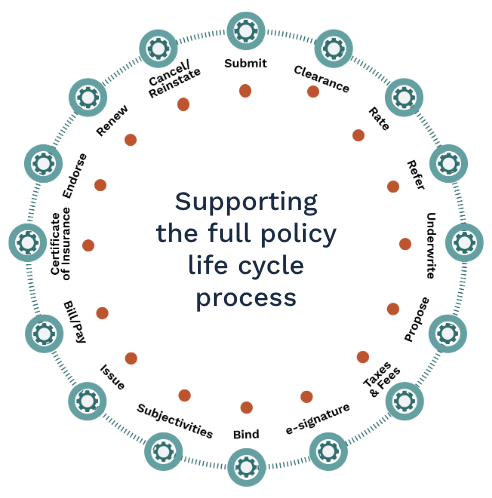When an insurance company implements a new digital strategy, it typically focuses on finding the IT resources needed to support new online business processes. Traditionally, this often meant buying or building a new policy administration system. However, insurance technology is evolving.
Today, organizations have much more flexible options thanks to cloud technology. Solartis Insure offers an insurance microservices platform that allows companies to fully utilize their assets and internal knowledge while leveraging third-party data sources and web services to manage the policy lifecycle more effectively than ever.
Three Steps to a Successful Digital Strategy
1. Gain Buy-in From All Key Stakeholders
Implementing a new digital strategy often represents a large shift in the business. Because it can be very expensive and resource-intensive, the plan needs the commitment of everyone who will be critical to its success, from the C-level down to the underwriters and other day-to-day users. Groups whose buy-in you’ll need include:
- Business leaders
- IT team
- Users
2. Identify Your Strategic Leader(s)
When unexpected obstacles and setbacks challenge the success of your digital strategy, you need dedicated leadership to keep pushing the project forward. Once upon a time, the CIO was the obvious choice. But today, technology isn’t the only factor—companies also need to consider the impact of digital deployments on customer experience and revenue generation.
A 2016 Gartner survey of 400 CEOs found that 36% of respondents believe the CIO, CTO, or IT department should be in charge of leading their company’s digital transformation. However, a contemporary survey of 500 digital experts found that these respondents were likelier to believe the CEO or CMO should be driving the digital strategy.
There’s no single “right” choice—every organization has to evaluate its own scenario and determine the individual or group in the best position to lead the project.
3. Assess Your Technology Environment
When you have achieved organizational alignment and selected strategic leaders, it’s time to start translating your digital strategy from concept to reality. This requires a hard look at your existing technology and the options available to replace the entire system or strategically replace the costly and/or labor-intensive sub-components.
Solartis makes this easy with its Solartis Insure technology platform, a complete set of insurance transaction micro web services in a secure and redundant, enterprise-level cloud environment that is available in three deployment options:
- Solartis Insure Rating Engine - This deployment model allows you to build or utilize your existing policy admin platform. Solartis provides the rating micro web services with ISO ERC.
- Solartis Insure Platform as a Service (PaaS) - In this deployment model, your technology team creates digital content, screens, apps, and business processes. Solartis supplies the sales and policy life cycle micro web services with ISO ERC or your rating content.
- Solartis Insure Software as a Service (SaaS) - In this model, we supply the total sales and/or policy life cycle system for your consumers, agents and/or underwriters.
Make Your Digital Strategy a Reality With Solartis Insure
"They are fast, simple, and cost-effective. Their team is an extremely reasonable group of people who care, really care, about your success. Every launch has some bumps - they worked above and beyond to make sure those bumps didn't disrupt our launch or our ability to write new business. Without Solartis, I wouldn't be projecting a 30% increase in topline growth."
said Cameron Linder, CEO, Western Bowling Proprietors Insurance (WBPI), Rednil Insurance Brokers, Inc.
With Solartis Insure, companies leverage existing third-party content (ISO rates, rules, and forms, Oden, Pitney Bowes, Zillow, etc.) with proven sales and policy lifecycle web services. Our flexible deployment options make it simple and cost-effective to enhance your existing technology environment or start a new one.
Best of all, with Solartis, you pay based on your technology usage versus the traditional pricing model, which is a large upfront license fee followed by annual maintenance fees. Solartis pricing is a pay-as-you-go model based on a revenue-related metric such as direct written premium. This changes your digital strategy implementation from a capital expense into an operating expense, while giving you maximum control over your branding, look and feel, functionality, and all other aspects of your digital transformation.
In conclusion, implementing a successful digital strategy in the insurance industry requires buy-in from all key stakeholders, identifying strategic leaders, and assessing the technology environment. With the evolving landscape of insurance technology, organizations now have more flexible options thanks to cloud technology.
Solartis Insure offers an insurance microservices platform that optimizes policy lifecycle management by leveraging third-party data sources and web services. With flexible deployment options, it provides a fast, simple, and cost-effective solution for enhancing or starting new technology environments.
To learn more about our policy administration microservices, check out our eBook, "Microservices Architecture and the Insurance Paradigm Shift."




